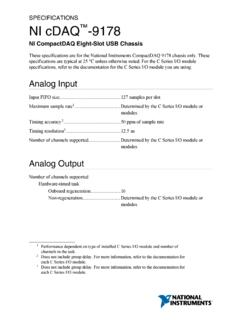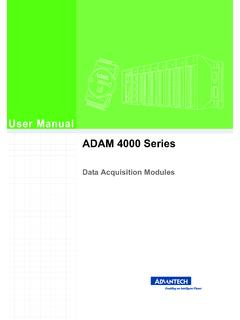Transcription of Compact™ 1769-IF4 (Series B or Later) Analog Input Module
1 Publication 1769-IN048A-EN-PInstallation InstructionsCompact 1769-IF4 ( series B or Later) Analog Input ModuleInsideModule Description .. 2 Module 3 System 4 Mounting Expansion I/O .. 6 Replacing a Single Module within a System ..8 Module Spare/Replacement Parts .. 8 Field Wiring 9I/O Memory Mapping .. 15 Specifications .. 17 Hazardous Location Considerations .. 20 Environnements dangereux .. 20 For More Information .. 212 Compact 1769-IF4 ( series B or Later) Analog Input Module Publication 1769-IN048A-EN-PModule DescriptionItem Description1bus lever (with locking function)2aupper panel mounting tab2blower panel mounting tab3module status LED4module door with terminal identification label5amovable bus connector with female pins5bstationary bus connector with male pins6nameplate label7aupper tongue-and-groove slots7blower tongue-and-groove slots8aupper DIN rail latch8blower DIN rail latch9write-on label (user ID tag)10removable terminal block (RTB)
2 With finger-safe cover10aRTB upper retaining screw10bRTB lower retaining screw10a10b4102b32a15a95b67a7b8b7b8a7a17 69-IF4 DANGERDo Not Remove RTB Under PowerUnless Area is Non-Hazardous Ensure AdjacentBus Lever is Unlatched/Latched Before/After Removing/Inserting ModuleANLGComV/I in 3 -+24V dcdcNEUTV/I in 1 -V/I in 2 -ANGLComANGLComV/I in 0 -V in 0 +V in 1 +V in 2 +V in 3 +I in 0+I in 1+I in 2+I in 3+ANLGComOKAnalogOKAnalogCompact 1769-IF4 ( series B or Later) Analog Input Module 3 Publication 1769-IN048A-EN-PModule InstallationCompact I/O is suitable for use in an industrial environment when installed in accordance with these instructions. Specifically, this equipment is intended for use in clean, dry environments (Pollution degree 2(1)) and to circuits not exceeding Over Voltage Category II(2) (IEC 60664-1).(3)Prevent Electrostatic Discharge(1) Pollution Degree 2 is an environment where, normally, only non-conductive pollution occurs except that occasionally a temporary conductivity caused by condensation shall be expected.
3 (2) Over Voltage Category II is the load level section of the electrical distribution system. At this level transient voltages are controlled and do not exceed the impulse voltage capability of the product s insulation.(3) Pollution Degree 2 and Over Voltage Category II are International Electrotechnical Commission (IEC) designations.!ATTENTIONE lectrostatic discharge can damage integrated circuits or semiconductors if you touch bus connector pins or the terminal block. Follow these guidelines when you handle the Module : Touch a grounded object to discharge static potential. Wear an approved wrist-strap grounding device. Do not touch the bus connector or connector pins. Do not touch circuit components inside the Module . If available, use a static-safe work station. When not in use, keep the Module in its static-shield Compact 1769-IF4 ( series B or Later) Analog Input Module Publication 1769-IN048A-EN-PRemove PowerSystem AssemblyThe Module can be attached to the controller or an adjacent I/O Module before or after mounting.
4 For mounting instructions, see Panel Mounting on page 6, or DIN Rail Mounting on page 7. To work with a system that is already mounted, see Replacing a Single Module within a System on page following procedure shows you how to assemble the Compact I/O system.!ATTENTIONR emove power before removing or inserting this Module . When you remove or insert a Module with power applied, an electrical arc may occur. An electrical arc can cause personal injury or property damage by: sending an erroneous signal to your system s field devices, causing unintended machine motion causing an explosion in a hazardous environmentElectrical arcing causes excessive wear to contacts on both the Module and its mating connector. Worn contacts may create electrical 1769-IF4 ( series B or Later) Analog Input Module 5 Publication that the bus lever of the Module to be installed is in the unlocked (fully right) the upper and lower tongue-and-groove slots (1) to secure the modules together (or to a controller).
5 The Module back along the tongue-and-groove slots until the bus connectors (2) line up with each the bus lever back slightly to clear the positioning tab (3). Use your fingers or a small allow communication between the controller and Module , move the bus lever fully to the left (4) until it clicks. Ensure it is locked firmly in an end cap terminator (5) to the last Module in the system by using the tongue-and-groove slots as before. the end cap bus terminator (6). !ATTENTIONWhen attaching I/O modules, it is very important that the bus connectors are securely locked together to ensure proper electrical 1769-ECR or 1769-ECL right or left end cap must be used to terminate the end of the communication Compact 1769-IF4 ( series B or Later) Analog Input Module Publication 1769-IN048A-EN-PMounting Expansion I/OMinimum SpacingMaintain spacing from enclosure walls, wireways, adjacent equipment, etc. Allow 50 mm (2 in.) of space on all sides for adequate ventilation, as shown:Panel MountingMount the Module to a panel using two screws per Module .
6 Use M4 or #8 panhead screws. Mounting screws are required on every Mounting Using the Dimensional Template!ATTENTIOND uring panel or DIN rail mounting of all devices, be sure that all debris (metal chips, wire strands, etc.) is kept from falling into the Module . Debris that falls into the Module could cause damage on power pBottomSideSideHost ControllerCompact I/OCompact I/OCompact I/OCompact I/OCompact I/OEnd CapHost ControllerCompact I/OCompact I/OCompact I/OEnd Cap132 ( ) ( )35( ) ( )Refer to host controller documentation for this more than 2 modules: (number of modules-1) X 35mm ( in.)NOTE: All dimensions are in mm (inches). Hole spacing tolerance: mm ( in.)Compact 1769-IF4 ( series B or Later) Analog Input Module 7 Publication 1769-IN048A-EN-PPanel Mounting Procedure Using Modules as a TemplateThe following procedure allows you to use the assembled modules as a template for drilling holes in the panel. If you have sophisticated panel mounting equipment, you can use the dimensional template provided on page 6.
7 Due to Module mounting hole tolerance, it is important to follow these a clean work surface, assemble no more than three the assembled modules as a template, carefully mark the center of all Module -mounting holes on the the assembled modules to the clean work surface, including any previously mounted and tap the mounting holes for the recommended M4 or #8 the modules back on the panel and check for proper hole the modules to the panel using the mounting steps 1 to 6 for any remaining Rail MountingThe Module can be mounted using the following DIN rails: 35 x mm (EN 50 022 - 35 x ) or 35 x 15 mm (EN 50 022 - 35 x 15).Before mounting the Module on a DIN rail, close the DIN rail latches. Press the DIN rail mounting area of the Module against the DIN rail. The latches will momentarily open and lock into mounting more modules, mount only the last one of this group and put the others aside. This reduces remounting time during drilling and tapping of the next Compact 1769-IF4 ( series B or Later) Analog Input Module Publication 1769-IN048A-EN-PReplacing a Single Module within a SystemThe Module can be replaced while the system is mounted to a panel (or DIN rail).
8 Follow these steps in order: power. See important note on page the Module to be removed, remove the upper and lower mounting screws from the Module (or open the DIN latches using a flat-blade or phillips-style screwdriver). the bus lever to the right to disconnect (unlock) the the right-side adjacent Module , move its bus lever to the right (unlock) to disconnect it from the Module to be slide the disconnected Module forward. If you feel excessive resistance, check that the Module has been disconnected from the bus and that both mounting screws have been removed (or DIN latches opened). installing the replacement Module , be sure that the bus lever on the Module to be installed, and on the right-side adjacent Module are in the unlocked (fully right) the replacement Module into the open the modules together by locking (fully left) the bus levers on the replacement Module and the right-side adjacent the mounting screws (or snap the Module onto the DIN rail).
9 Module Spare/Replacement Parts Terminal block, catalog number 1769-RTBN18 (1 per kit) Door Labels, catalog number 1769-RL2 series B (2 per kit) Door, catalog number 1769-RD (2 per kit)NOTEIt may be necessary to rock the Module slightly from front to back to remove it, or, in a panel-mounted system, to loosen the screws of adjacent 1769-IF4 ( series B or Later) Analog Input Module 9 Publication 1769-IN048A-EN-PField Wiring ConnectionsGrounding the ModuleThis product is intended to be mounted to a well-grounded mounting surface such as a metal panel. Additional grounding connections from the Module s mounting tabs or DIN rail (if used), are not required unless the mounting surface cannot be grounded. Refer to Industrial Automation Wiring and Grounding Guidelines, Allen-Bradley publication , for additional Wiring GuidelinesConsider the following when wiring your system: All Module commons (ANLG COM) are connected in the Analog Module . The Analog common (ANLG COM) is not connected to earth ground inside the Module .
10 Do not use the Analog Module s NC terminals as connection points. Channels are not isolated from each other. Use Belden 8761, or equivalent, shielded wire. Under normal conditions, the drain wire and shield junction must be connected to earth ground via a panel or DIN rail mounting screw at the Analog I/O Module end. Keep the shield connection to ground as short as possible.(1) To ensure optimum accuracy, limit overall cable impedance by keeping your cable as short as possible. Locate the I/O system as close to your sensors or actuators as your application will permit. If multiple power supplies are used with Analog inputs, the power supply commons must be connected.(1) In environments where high-frequency noise may be present, it may be necessary to directly ground cable shields to earth at the Module end and via a F capacitor at the sensor Compact 1769-IF4 ( series B or Later) Analog Input Module Publication 1769-IN048A-EN-P The 1769-IF4 Module does not provide loop power for Analog inputs.















